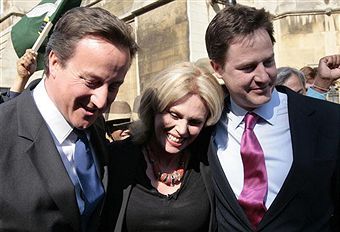 With even Michael Portillo predicting a hung parliament, what would Britain’s post-election government actually look like if the Tories did not secure an over-all majority.
With even Michael Portillo predicting a hung parliament, what would Britain’s post-election government actually look like if the Tories did not secure an over-all majority.
The Tories could form a minority government, hoping to persuade enough MPs from other parties, but principally the Liberal Democrats, to vote with them on the key issues. Such a government would be inherently unstable, lurching from vote to vote and dependent on the relationship between a Prime Minister Cameron and Nick Clegg, the Liberal Democrat leader, as well as between George Osborne, the would-be Chancellor, and Vince Cable, who many think is a more qualified potential occupant of No 11. Party leaders would always be eyeing each other with suspicion, fearful that David Cameron would call a quick follow-up election.
The second option is to build some kind of coalition, where the Conservatives and the other parties bat Labour back a series of policies. This is also problematic, as the Tories and the Liberal Democrats disagree on a number of key issues, including electoral reform – the issue that tore Tony Blair away from Paddy Ashdown after the 1997 election. It would also give the Liberal Democrats a lot of cards. They would be able to dictate policy, but not be responsible for any mistakes. In power but not in office, so to speak. This has been a tactic used skilfully in Denmark by the Danish People’s Party, which has gained electorally as a result.
The third possibility would be a formal Conservative-Liberal Democrat government. Here the struggle over policy could look easy compared to the fight over top jobs. But what could such a coalition government look like?
David Cameron would obviously be Prime Minister and Nick Clegg his deputy. But what else would the Liberal Democrat leader want – and get? If he opts for the chancellorship he is going to be put in charge of the economic recovery – with all the risks that entails – and have Vince Cable as a back-seat driver in the party. It is also hard to see Cameron abandoning Osborne so easily.
Clegg may be shrewder to demand that Vince Cable get Peter Mandelson’s job. The former banker would then, de facto, become deputy chancellor while the Cameron/Osborne axis, so crucial for the modern Tory party, would remain intact.
Equally, Clegg could ask for the Foreign Office, like the German FDP leader, Guido Westerwelle, has done in Angela Merkel’s government. But then what of William Hague? If Tory plans for a National Security Council go ahead – and there is no reason why they would not, as the Liberal Democrats have no alternative – foreign policy would probably be directed from the centre. The post of Secretary of State for National Security in the Cabinet Office could be created to oversee foreign and defence policy and filled by Hague. But then Clegg is unlikely to accept an essentially subordinate post.
It may be better to install Clegg in 1 Carlton Gardens and put Hague in the Ministry of Defence. That, of course, would push out Liam Fox and prevent a Liberal Democrat, like Paddy Ashdown, taking over the portfolio. But this arrangement may be best for Cameron and Clegg – who would retain confidantes in key positions. Liam Fox could then be offered either the Home Office or Health.
Experience from Germany shows that to preserve the functionality of government it is better to “give” one party a whole ministry, rather than have ministers from different parties in one ministry. But there would be many other junior posts to be filled. Such a government would also need a special coordination body, comprised only of two or three people from each party, who would trash out agreements between the parties before Cabinet meetings.
None of this may be attractive, but it could be what the voters want. Civil servants are busy drawing up plans for how to react constitutionally in case of a hung parliament. But party leaders should at least begin thinking about the political options that may be before them.






Comments